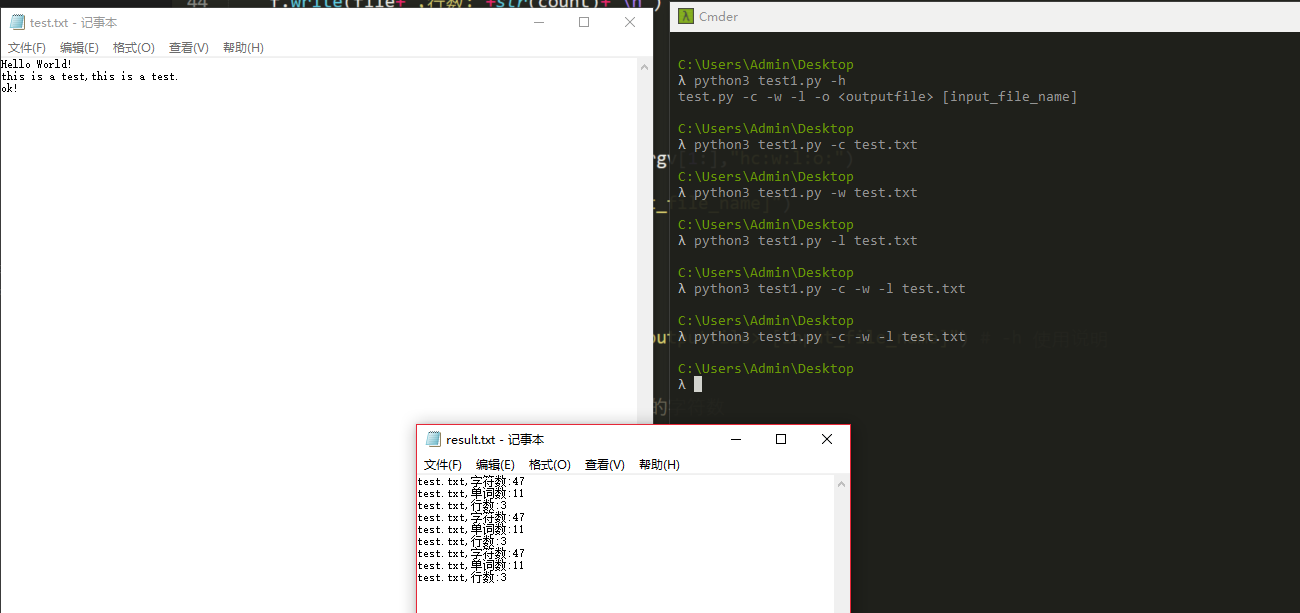Gitee地址:https://gitee.com/c1e4r/word-count(为什么老师不让我们用github)
0x00 前言
好久没发博客了,感觉自己的学习是有点偷懒了。这篇博客也是应专业课程老师作业硬性的要求才发的,希望借这次机会,自己能够再次出发,努力向前吧。
0x01 作业思路
老师在课堂上布置了一个作业,总的来说是对一个源文件进行各方面的字符统计,涉及到了文件和字符读取等操作。具体要求如下:

其实要求很简单,主要就是文件读写操作,又必须是用命令行进行,python中自带的sys库和getopt库可以从命令行中获取参数,所以就果断用python来解决了。
0x02 基本实现过程
基本功能只有三个:统计源文件字符,统计源文件单词,统计源文件行数
所以就只需要写三个功能函数加上一个主函数即可实现其功能。话不多说,直接先贴代码:
#Author:c1e4r import sys import getopt #读取指定文件中的字符数 def read_str(file2): file = sys.argv[-1] file1 = open(file,'r+') count = 0 for line in file1.readlines(): count_line = len(line) count += count_line f = open(file2,'a+') f.write(file+",字符数:"+str(count)+' ') file1.close() f.close() #读取指定文件中的单词数 def read_word(file2): file = sys.argv[-1] file1 = open(file,'r+') count = 0 for line in file1.readlines(): line = line.replace(","," ") line = line.replace("."," ") line = line.replace("!"," ") line = line.replace("?"," ") line_word = len(line.split( )) count += line_word f = open(file2,'a+') f.write(file+",单词数:"+str(count)+' ') file1.close() f.close() #读取指定文件中的行数 def read_line(file2): file = sys.argv[-1] file1 = open(file,'r+') count = 0 for line in file1.readlines(): count += 1 f = open(file2,'a+') f.write(file+",行数:"+str(count)+' ') file1.close() f.close() def main(): file = "result.txt" try: opts, args = getopt.getopt(sys.argv[1:],"hc:w:l:o:") except getopt.GetoptError: print("test.py [parameter] [input_file_name]") sys.exit(2) finally: pass for opt,arg in opts: if opt == '-h': print("test.py -c -w -l -o <outputfile> [input_file_name]") # -h 使用说明 sys.exit() elif opt == "-c": read_str(file) # -c 返回文件的字符数 elif opt == "-w": read_word(file) # -w 返回文件的单词总数 elif opt == "-l": read_line(file) # -l 返回文件的总行数 elif opt == "-o": file = arg # -o 输出结果的文件 if __name__ == "__main__": main()
其中稍微有点棘手的是统计文件中的单词数量。因为单词和单词之间不一定是空格(可能是各种标点符号),所以就先把每一行中的标点符号替换成空格,最后用split切割,这样每个单词就被筛选出来了。
for line in file1.readlines(): line = line.replace(","," ") line = line.replace("."," ") line = line.replace("!"," ") line = line.replace("?"," ") line_word = len(line.split( ))
其他的功能其实就是一个逐行读然后计算的过程,很基础,所以就不做解析了。
0x04 效果截图
程序的效果如下:

后面还要求做个图形化界面。。。我还是老老实实加油学安全吧。
参考文献: Python命令行参数和getopt模块